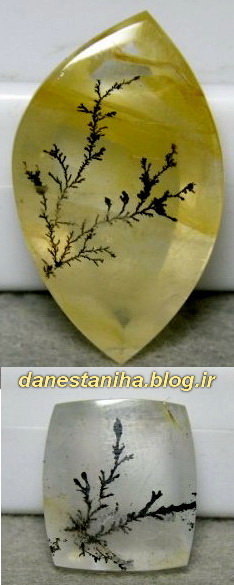یکی دیگر از انواع کالسیدونی است که اغلب بصورت تودهای با لایههایی از رنگهای گوناگون یافت میشود و مشهورترین نوع کالسیدونی میباشد. سختی فوقالعاده و زیبایی رنگها در آن، آن را به سنگی مورد علاقه عموم تبدیل کرده است. عقیق به رنگهای آبی و سبز نیز دیده میشود.مسبب این رنگها اغلب بلورهای بسیار ریز از اکسید آهن و یا منگنز میباشد. عقیق معمولا در حفرههای سنگهای ولکانیک یافت میشود. آبهای گرم غنی در سیلیس در این حفرهها لایه به لایه بلورهای میکروسکوپیک را در باندهای موازی یا دیواره حفرهها رسوب گذاری میکند. تنوع رنگها و ساختارهای به وجود آمده موجب نامگذاریهای متعددی شده است، مانند عقیق خزهای، شجری، عقیق چشمی، عقیق لایهای، عقیق دژسان، عقیق آبدار، عقیق منظرهای، عقیق مجوف، عقیق یمنی، شبه عقیق، عقیق حشرهای و غیره...


A
crystal dendrite is a crystal that develops with a typical
multi-branching tree-like form. Dendritic crystal growth is very common
and illustrated by snowflake formation and frost patterns on a window.
Dendritic crystallization forms a natural fractal pattern. Dendritic
crystals can form from growth instabilities that occur when the growth
rate is limited by the rate of diffusion of solute atoms to the
interface. In this case, there must be a concentration gradient from the
supersaturated value in the solution to the concentration in
equilibrium with the crystal at the surface. Any protuberance that
develops is accompanied by a steeper concentration gradients at its tip.
This increases the diffusion rate to the tip. In opposition to this is
the action of the surface tension tending to flatten the protuberance
and setting up a flux of solute atoms from the protuberance out to the
sides. However, overall, the protuberance becomes amplified. This
process occurs again and again until a dendrite is produced.
The term "dendrite" comes from the Greek word dendron, which means "tree".
Contents
•1 Mineralogy and paleontology
•2 Crystallography and metallurgy
•3 NASA microgravity experiment
•4 See also
•5 References
Mineralogy and paleontology
In
paleontology, dendritic mineral crystal forms are often mistaken for
fossils. These pseudofossils form as naturally occurring fissures in the
rock are filled by percolating mineral solutions. They form when water
rich in manganese and iron flows along fractures and bedding planes
between layers of limestone and other rock types, depositing dendritic
crystals as the solution flows through. A variety of manganese oxides
and hydroxides are involved, including:
•birnessite (Na4Mn14O27•9H2O)
•coronadite (PbMn8O16)
•cryptomelane (KMn8O16)
•hollandite (BaMn8O16)
•romanechite ((Ba,H2O)Mn5O10)
•todorokite ((Ba,Mn,Mg,Ca,K,Na)2Mn3O12•3H2O) and others.
A three-dimensional form of dendrite develops in fissures in quartz, forming moss agate.
Crystallography and metallurgy
The
Isothermal Dendritic Growth Experiment (IDGE) is a materials science
solidification experiment that researchers use on Space Shuttle missions
to investigate dendritic growth. Dendritic solidification is one of the
most common forms of solidifying metals and alloys. When materials
crystallize or solidify under certain conditions, they freeze unstably,
resulting in dendritic forms. Scientists are particularly interested in
dendrite size, shape, and how the branches of the dendrites interact
with each other. These characteristics largely determine the properties
of the material.
